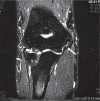Medial elbow pain
- PMID: 28932488
- PMCID: PMC5590003
- DOI: 10.1302/2058-5241.2.160006
Medial elbow pain
Abstract
Medial elbow pain is uncommon when compared with lateral elbow pain.Medial epicondylitis is an uncommon diagnosis and can be confused with other sources of pain.Overhead throwers and workers lifting heavy objects are at increased risk of medial elbow pain.Differential diagnosis includes ulnar nerve disorders, cervical radiculopathy, injured ulnar collateral ligament, altered distal triceps anatomy or joint disorders.Children with medial elbow pain have to be assessed for 'Little League elbow' and fractures of the medial epicondyle following a traumatic event.This paper is primarily focused on the differential diagnosis of medial elbow pain with basic recommendations on treatment strategies. Cite this article: EFORT Open Rev 2017;2:362-371. DOI: 10.1302/2058-5241.2.160006.
Keywords: elbow; medial elbow pain; medial epicondylitis; sports; ulnar collateral ligament; ulnar neuritis.
Conflict of interest statement
ICMJE Conflict of interest statement: Raul Barco is a board member of SECEC, ESSKA and SECHC, and reports consultancy and payment for lectures from Exactech, Conmed and Acumed, outside the submitted work. Samuel A. Antuña is a board member of the Journal of Shoulder and Elbow Surgery, consults for Exactech and receives payment for development of educational presentations from Zimmer Biomet and Acumed, outside the submitted work.
Figures







References
-
- Shiri R, Viikari-Juntura E, Varonen H, Heliövaara M. Prevalence and determinants of lateral and medial epicondylitis: a population study. Am J Epidemiol 2006;164:1065-1074. - PubMed
-
- Shiri R, Viikari-Juntura E. Lateral and medial epicondylitis: role of occupational factors. Best Pract Res Clin Rheumatol 2011;25:43-57. - PubMed
-
- David TS. Medial elbow pain in the throwing athlete. Orthopedics 2003;26:94-105. - PubMed
-
- Lynch JR, Waitayawinyu T, Hanel DP, Trumble TE. Medial collateral ligament injury in the overhand-throwing athlete. J Hand Surg Am 2008;33:430-437. - PubMed
-
- Cesmebasi A, O’Driscoll SW, Smith J, Skinner JA, Spinner RJ. The snapping medial antebrachial cutaneous nerve. Clin Anat 2015;28:872-877. - PubMed
Publication types
LinkOut - more resources
Full Text Sources
Other Literature Sources

